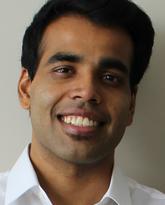
Govind Peringod
Graduate student - PhD
Contact information
Biography
About me
I am originally from India, I grew up in the Middle East, and immigrated to Canada in 2010. I went to high school in Okotoks and then moved out east to study Engineering Science at the University of Toronto. I returned to Calgary to be closer to the Rockies, to study at one of the best neuroscience research institutes in the country, and to be a part of the exciting entrepreneurial ecosystem here. In my spare time, I volunteer in dementia wards at Rockyview Hospital, I run a technology startup focused on improving eczema care for young children, and I love taking aerial photographs of nature and wildlife.
My research
Previously, I was a summer student in Dr. Grant Gordon’s lab at the Hotchkiss Brain Institute in Calgary, and an Honours student in Dr. Lyanne Schlichter’s lab at the Krembil Research Institute in Toronto. I then did my MSc Neuroscience in Dr. Gordon’s lab, and am now doing a PhD Neuroscience under the co-supervision of Dr. Gordon and Dr. Jaideep Bains (https://stressynomics.com/). I am using a combination of awake-animal two-photon calcium imaging, fiber photometry and an array of behavioural tests to study the role of glial cells in the pathophysiology of stress, anxiety and depression. I also do some pro bono technical consulting for other research labs within the Institute, and within the community.
BRAIN CREATE program aspirations
As a BRAIN CREATE trainee, I am keen to participate in the extreme physiology project/expedition at the ALMA high-altitude observatory in Chile. I am also interested in doing an industrial work placement, ideally working on a project that is related to technology development with strong clinical/commercial potential. During my time in the BRAIN CREATE program, I aim to participate in innovation challenges and health hackathons to discover problems worth solving, meet talented people and learn new professional and technical skills.
Commercialization
A side-project for my PhD involves adapting an imaging system developed by our collaborators at UBC. In this paradigm, mice are trained to undergo voluntary, mechanical head-restraint via an implanted headbar within their homecage. While they are head-fixed and receiving water rewards, brain activity will be assessed on a regional scale (with LED-based widefield optical imaging) or cellular scale (with laser-based two-photon imaging). The awake nature of the animals and the minimization of experimenter-animal interactions improves quality of the data and speeds up data collection. Instrumentation, hardware and software for this system can also be readily adapted to different tasks (e.g. sensory stimulation, go/no-go decision-making). Thus, we believe that this technology can enable both basic discovery of new brain phenomena and improve pre-clinical work in various disease models. We anticipate that some aspects of this setup may have commercial value.
Awards
Canadian Open Neuroscience Platform Scholarship
BRAIN CREATE Graduate Scholarship
Eyes High Doctoral Recruitment Scholarship
Alberta Graduate Scholarship
Donald Burns and Louise Berlin Graduate Award in Dementia Research
University of Toronto / Bank of Montreal National Scholarship

